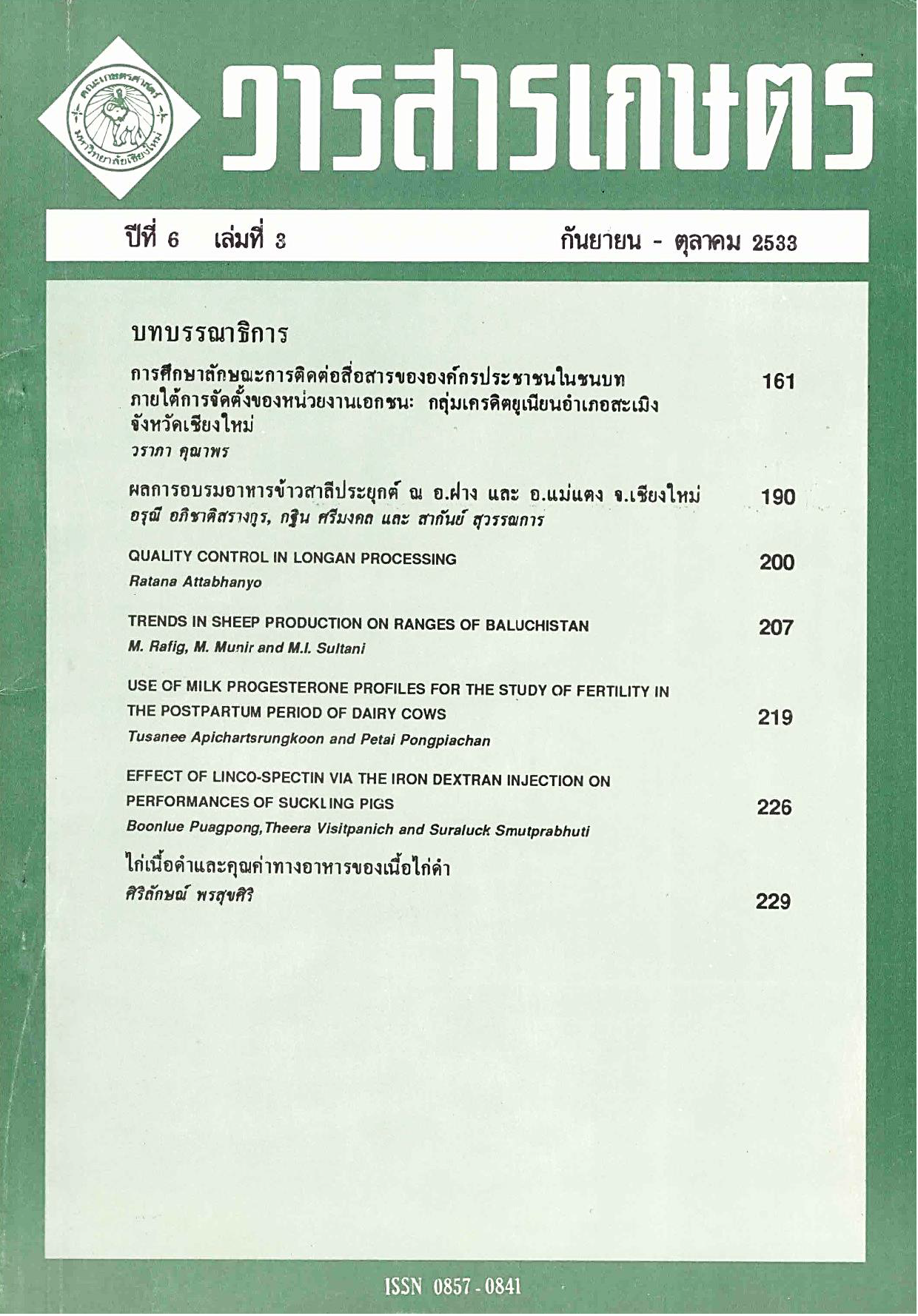ไก่เนื้อดำและคุณค่าทางอาหารของเนื้อไก่ดำ
Main Article Content
บทคัดย่อ
ในการศึกษาถึงลักษณะต่าง ๆ ของไก่เนื้อดำ จะต้องศึกษาเกี่ยวกับโครงสร้างของผิวหนัง เม็ดสีต่าง ๆ ที่มีผลต่อสีผิวและพันธุกรรมที่มีผลต่อการกระจายของเม็ดสี ซึ่งพบว่า การที่ไก่มีเนื้อดำเนื่องจากยืนที่ควบคุมบนโครโมโซมเพศคอยยับยั้งหรือสะสมเม็ดสีเมลานิน ซึ่งส่วนใหญ่กระจายอยู่ในชั้นของหนังชั้นในหรือบริเวณพังผืดต่าง ๆ ขบวนการเกิดเม็ดสีเมลานิน เป็นขบวนการทางชีวเคมีที่เกิดขึ้นในร่างกายสำหรับคุณค่าทางอาหารของเนื้อไก่ดำเมื่อวิเคราะห์โดยวิธีทางเคมีปรากฏว่าผันแปรไปตามพันธุ์เพศและตำแหน่งของเนื้อและไม่มีความสัมพันธ์กับปริมาณเมลานิน ในการศึกษาลักษณะพิเศษด้านคุณค่าทางอาหารของเนื้อไก่คำเมื่อนำไปอุ่นผสมกับเครื่องยาจีนโดยเปรียบเทียบกับเนื้อไก่ปกติในหนูทดลองปรากฏว่า ความแตกต่างไม่มีนัยสำคัญ แต่อย่างใด แต่เนื้อไก่ทั้งสองชนิดที่ตุ๋นผสมกับเครื่องยาจีนทำให้หนูทดลองมีการเจริญเติบโตดีกว่ากลุ่มที่ไม่ใช้เครื่องยาจีน (P <0.5).
Article Details
เอกสารอ้างอิง
พรสุขศิริ, ศิริลักษณ์ (2530), การศึกษาลักษณะบางประการของไก่เนื้อดำและลูกผสมเกี่ยวกับการเจริญเติบโตคุณค่าทางอาหาร และลักษณะของเม็ดสีเมลานิน. วิทยานิพนธ์ปริญญาโท. มหาวิทยาลัยเกษตรศาสตร์, กรุงเทพฯ
สิริพลวัฒน์, วรวิทย์ (2527), ข้อสังเกตบางประการเกี่ยวกับไก่เนื้อดำ. เกษตรวันนี้ 41(2) 76-78.
อิสริโยดม สุภาพร (2528). ส่วนประกอบทางเคมี ค่าทางโลหิตวิทยาของไก่ดำบางพันธุ์เปรียบเทียบกับไก่เนื้อขาวและอิทธิพลของระดับโปรตีนในอาหารที่มีผลต่อการเจริญเติบโตของไก่เนื้อดำบางสายพันธุ์.รายงานความก้าวหน้า โครงการวิจัยการปรับปรุงการผลิตไก่เนื้อดำเพื่อการส่งตลาด. มหาวิทยาลัยเกษตรศาสตร์, กรุงเทพฯ. 5 หน้า
Barrows, H.R. (1914). The histological basis of the different shank colors in the domestic fowl. Marine Agr. Exp. Sta. Bull. 232 p.
Britlon, G. (1983). The Biochemistry of Natural Pigments. Cambridge Univ. Press, Cambridge. 465 p.
Davenport, C.B. (1906). Inheritance in Poultry. Carnegie Inst. Wash. Pub., Washongtin. 52 p.
Edwards, H.M. , Jr. and Denman, F. (1975). Carcass composition studies. 2. Influence of breed, sex and diet on gross composition of carcass and fatty acid composition of adipose tissue. Poultry Sci. 54: 1230-1238.
Fitzpatrick, T.B. (1958). The Nature of Hair Pigment. Academic Press, New York. 238 p.
Gornitz, K. (1923). Versuch einer Klassifikation der haufigsten Federfarbungen. Taschb. F. Ornithol, pp. 127-137. Citedby R.G. Somes, Jr. and J.R. Smyth. Feather phaeomelanin intensity in buff Orpington, New Hamphire and Rhode Island Red breeds of fowls. Poultry Sci. 44: 40-46.
Harris, H. (1959). Human Biochemical Geneties. Cambridge Univ. Press, Cam bridge. 253 p.
Hart, F.L. and Fisher, H.J. (1971). Model Food Analysis. Springer Verlag, New York. 46 p.
Hutt, F.B. (1949). Genetics of the Fowl. McGraw-Hill Book Co, New York. 415 p.
Kukbuski, J. (1915). Uber das Vorkomen und die Verteilung des Pigmentes in den Organen und Geweben bei japanishen Seidenhuhnen, pp. 1-37. Cited by F.B. Hutt. Genetics of the Fowl. McGraw-Hill Book Co. , New York. 415 p.
Leeson, S. and Summers, J.D. (1980). Production and carcass characteristics of the broiler chicken. Poultry Sci. 59: 786-798.
Mason, H.S. (1948). Biology of Melanomas. McGraw-Hill Book Co. , New York. 399 p.
Searle, A.G. (1967). Comparative Genetices of Coat Colour in Mammal. Garden City Press, Hertfordshire. 308 p.
Seiji, M. and Fitzpatrick, T.B. (1961). Nature, p. 1082. Cited by A.G. Everson Pearse. Histochemistry Theoretical and Applied. 3d ed., Churchill Livingstone Inc., New York. 1055 p.
Seiji, M. , Shimao, K. and Fitzpatrick, T.B. (1963). Subcellular localization of melanin biosynthesis. Ann. N.Y. Acad. Sci. 100: 497-533.
Stolle, J. (1968). Comparative investigations of the pigmentation of Silky and Italian fowls and their crossbreds. Wilhelm. Rouse 'Arch. Ento. Mech. Org. 161: 30-48.
Wellings, S.R. and Siegel, B.V. (1963). Electron microscopic studies on the subcellular origin and ultrastructure of melanin granules in mammalian melanomas. Ann. N.Y. Acad. Sci. 100: 548-568.
Zimmerman, J. (1982). Four new proteins of the eumelanosome matrix of the or chick pigment epithelium. J. Exp. Zool. 219: 1-6.


